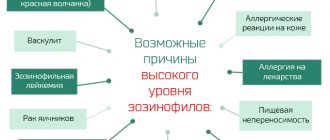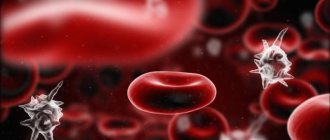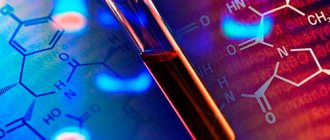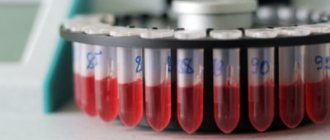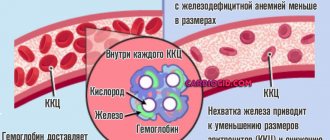- home
- Blood analysis
- Blood chemistry
The level of iron in the blood for women is an important indicator that reflects the efficiency of the hematopoiesis process. Its deviation indicates a change in the process of oxygen transport during blood circulation through the vessels. The needs of the female body for this element exceed those of men. This is due to the peculiarities of its functioning and the loss of a small amount of blood every month during menstrual bleeding.
Factors that increase iron
Why does the human body need iron?
In total, it contains about 4–5 grams of this important trace element. Of the total amount, 2.5 g is included in the blood, the rest is deposited in the liver, spleen, kidneys, heart muscle and bone marrow. This substance is a component of 100 enzymes. The role of iron in the human body is as follows.
- Without it, hematopoiesis is impossible. It is part of hemoglobin, which supplies oxygen to organs and carries carbon dioxide to the lungs.
- As part of enzyme-cytochromes, it carries out electron transfer.
- Forms the immune system, promoting the formation of antibodies.
- Provides DNA synthesis and cell division.
- Participates in the metabolism of adrenal hormones.
- Reduces the level of toxic substances.
- As part of cytochrome P450, it ensures human performance. With its deficiency, physical activity decreases.
Most of the microelement is necessary to meet the needs of hematopoiesis. Red blood cells function in the blood no longer than 60–90 days. Aging cells become less elastic and break down inside the blood vessels. Some of them are captured by macrophages in the spleen, which in medicine is called the “graveyard of red blood cells.” Iron is needed to renew red blood cells.
The trace element is involved in all redox processes, without which there cannot be healthy skin, hair and nails. When it decreases, the function of the thyroid gland decreases.
The level of iron in the body depends on age and gender (µmol/l):
- children under 2 years old - 7–8;
- child from 2 to 14 years old - 9–22;
- women - 9–30;
- men - 11–31.
The level of microelement is affected by height, weight, and the amount of hemoglobin in the blood.
This metal is not produced in the body. Depending on age and gender, a person should receive per day:
- women - 20 mg, and during pregnancy - 30 mg;
- men - 10 mg;
- children depending on age 4–18 mg;
- elderly people - 8 mg.
An increased amount of this element can also be obtained from water or by cooking food in a metal container.
Excess iron in the body can be a consequence of certain diseases.
- Hemochromatosis or hemosiderosis. The inherited gene provokes an increase in the absorption of the microelement in the intestine.
- Chronic hepatitis B and C.
- Liver tumors.
- Leukemia.
- Nephritis.
- Blockage of the pancreatic duct.
- Hemolytic anemia.
- Thalassemia.
Excess iron in the blood can also be due to other reasons:
- excessive use of iron supplements;
- injections of drugs for anemia;
- frequent blood transfusions.
Risk factors contributing to the accumulation of this trace element may be:
- its high content in drinking water;
- cooking in metal utensils.
The metal is often found in artesian wells, from which people regularly drink. Excess iron in water has the following negative effects on the body:
- promotes the deposition of all types of stones;
- thickens the blood;
- causes hardening of the vascular walls.
There is a lot of iron in those regions where the source of water supply is an artesian well. According to the law, its content in water should not exceed 0.3 mg per 1 dm³. In such areas, it is necessary to install filters in houses and apartments to remove metals.
Physiological blood loss during reproductive age protects women from trace element excess before menopause. But with age, after monthly blood loss stops, there is a risk of its accumulation, which is compared with this possibility in men.
Increased levels of iron in the blood of women are observed after taking oral contraceptives and hormonal drugs. During gestation, the amount of metal required increases for the formation and formation of organs. Excess iron during pregnancy is observed in the third trimester.
Signs of excess are the following:
- prostration;
- nausea;
- discomfort in the abdominal area;
- swelling of the joints;
- pain in the right hypochondrium;
- hyperpigmentation - a gray-brown tint of the skin, mucous membranes and sclera;
- weakening of sexual desire;
- rapid weight loss;
- decrease in the number of red blood cells;
- arterial hypotension.
When a trace element accumulates in tissues, a person loses vital activity.
This microelement, so necessary and necessary for our body, poses a threat to humans in large doses. Its accumulation in the tissues of internal organs leads to their degradation.
Possible consequences of chronic excess iron in the body:
- liver failure;
- depressive effect on the heart - arrhythmia, myocardial infarction;
- varicose veins of the esophagus with bleeding;
- diabetes;
- cirrhosis of the liver.
This element accumulates especially quickly in the body of men. Research at Harvard has shown a relationship between excess iron in the body and the incidence of myocardial infarction. The higher the level of a trace element, the greater the risk of acute heart disease. Attacks of heart pain can appear as early as 30–35 years of age.
This metal is an oxidant, that is, it promotes the production of free radicals, which provoke the formation of malignant cells and accelerate the aging of the body. In women with breast cancer, the amount of the element is 5 times higher than normal. The risk of cancer increases in people suffering from hemochromatosis.
How to remove iron from the body? Toxicologists have developed a set of therapeutic measures to reduce it and reduce clinical manifestations.
- Special diet. Foods high in iron, the main supplier of which is meat, are removed from the menu. It is recommended to consume dairy products, which limit the absorption of this trace element. It is not recommended to take vitamin C.
- Elimination of alcohol - alcoholic drinks stimulate the absorption of iron from the intestines.
- Another method is bleeding 450 ml of blood. For patients with hemochromatosis, the procedure is performed 2 times a week.
- Cytopheresis is a modern treatment method. The patient's blood is taken, the cells are removed from it, and the plasma is returned during a subsequent infusion. The course of treatment consists of 10 procedures.
- Use of the drug "Desferal". According to its chemical structure, it consists of 2 claws capable of capturing and removing metal in urine.
It is recommended to drink water - it also helps eliminate excess microelements. In addition to these methods, you need to pay attention to the dishes in which you cook food - they should not be metal.
To summarize, let us recall the main points of the article. Iron poisoning at home most often occurs as a result of self-medication with anti-anemia pills and taking dietary supplements. Severe intoxication is observed in children with an overdose of tablets. Excess also accumulates in diseases associated with impaired iron metabolism in the body.
Iron is an integral part of many enzymes and proteins, including hemoglobin and the red blood cells that form it. It affects various functions:
- responsible for oxygen transport;
- ensures regeneration and normal cell growth;
- strengthens the body's immunity;
- ensures oxygen transport and carbon dioxide evacuation - regulates cellular respiration;
- regulates metabolism - metabolic processes;
- determines the proper functioning of almost all organs and systems.
Iron excess is much less common than iron deficiency. What are the consequences of this condition? Excess iron can be very dangerous for us. Its elements accumulate in the liver or pancreas and cause poisoning of the body.
Typical symptoms of iron excess are general weakness, fatigue, and often mental discomfort. There is weight loss, as well as joint pain.
It is worth noting that the problem of excess iron mainly affects middle-aged men. And since the symptoms are not typical, they are often confused with fatigue or lack of nutrients. If this situation persists for a long time without a correct diagnosis, extreme exhaustion and lack of energy occurs.
If the problem affects women, then they usually have problems with hormonal levels and irregularities during menstruation.
Decreased libido is observed in both men and women.
Another warning sign may be a change in skin color to a sallow, gray-brown color combined with a metallic sheen. In addition, hair in the pubic area and armpits may disappear.
Blood test results show abnormal liver enzymes, which contribute to liver problems.
As iron levels in the blood increase, LDL cholesterol, glucose, and triglyceride levels increase, and blood pressure also increases.
The consequences of overloading the body with iron are very dangerous to health. Problems with joints, heart, liver, and pancreas may occur. There is also a violation of the lipid profile - fat metabolism processes. This chronic condition can lead to the development of diabetes or cirrhosis of the liver.
An excess of this element causes hormonal imbalances and can even lead to the development of tumors.
The musculoskeletal system is subject to chronic inflammation and degeneration, which significantly complicates movement and also causes pain.
Excess iron promotes the growth of bacteria, which can lead to serious complications (for example, sepsis).
Causes of excess iron in the blood
Excessive amounts of iron in the blood may be caused by a diet rich in this element, which is based mainly on red meat because it is rich in heme iron, which is the best absorbable form of the element. The second, very important reason for the appearance of excess iron is a metabolic disorder - hemochromatosis (pigmentary cirrhosis, bronze diabetes), which is associated with excessive absorption of iron from the gastrointestinal tract obtained from food.
There are two forms of this disease: primary and secondary. The primary form is associated with the inheritance of a gene mutation that is responsible for controlling iron absorption in intestinal epithelial cells. This causes the defective gene to be inherited from both parents. Therefore, this is a rare form of the disease.
- Children and adolescent males need 11 mg of iron per day.
- Men over 19 years of age should receive, on average, 8 mg of iron per day.
- about a lack of vitamins B6, B12, folic acid;
- about the presence of anemia of any type;
- about poisoning of the body with products containing excessive amounts of Fe.
- primary type hemachromatosis;
- hemolytic anemia;
- hepatitis;
- thalassemia;
- nephritis;
- hyperchromic anemia;
- hypoanemia.
- fatigue;
- abdominal pain (in the liver area);
- hair loss;
- weight loss;
- shortness of breath;
- impotence;
- increase in liver size;
- joint diseases.
- Excessive absorption in the gastrointestinal tract due to a violation of the limiting mechanism (hemochromatosis).
- Nephritis. Kidney disease, in which the utilization of old elements from the blood is impaired.
- Liver lesions (viral and acute hepatitis of any origin, acute liver necrosis, chronic cholecystitis, various hepatopathies).
- Lead poisoning. During intoxication, the breakdown of red blood cells increases and the functions of organs involved in hematopoiesis are disrupted.
- Iron poisoning. Occurs due to excessive use of iron supplements.
- Iron levels may also increase due to long-term use of medications, especially hormones and contraception.
Normal level of iron in the body
In blood serum, iron is found in complex with a protein that binds and transports it – transferrin (25% Fe). Typically, the reason for calculating the concentration of an element in the blood serum (serum iron) is a low level of hemoglobin, which, as is known, is one of the main parameters of a general blood test.
The level of iron in the blood fluctuates throughout the day, its average concentration for men and women is different and is: 14.30 - 25.10 µmol per liter of male blood and 10.70 - 21.50 µmol/l in women . Such differences are largely due to the menstrual cycle, which affects only individuals of a certain gender. With age, the differences disappear, the amount of the element decreases in both men and women, and iron deficiency can be observed to the same extent in both sexes. The level of iron in the blood of infants, as well as children and adults, male and female, is different, therefore, to make it more convenient for the reader, it is better to present it in the form of a small table:
| Gender and age | Norm in µmol/l |
| Infants up to one year old | 7,16 – 17,9 |
| Children and teenagers from one to 14 years old | 8,95 – 21,48 |
| Boys and adults | 11,64 – 30,43 |
| Girls and adult women | 8,95 – 30,43 |
However, it should be borne in mind that, like other biochemical indicators, normal blood iron levels may vary slightly from one source to another. In addition, we consider it useful to remind the reader of the rules for passing the analysis:
- Blood is donated on an empty stomach (it is advisable to fast for 12 hours);
- A week before the study, pills for the treatment of IDA are discontinued;
- After a blood transfusion, the analysis is postponed for several days.
To determine the level of iron in the blood, serum is used as a biological material, that is, blood is taken without an anticoagulant into a dry new tube that never comes into contact with detergents.
What does increased hemoglobin mean?
It should be noted that iron is the strongest oxidant. It combines with free radicals. And this leads to rapid aging of the entire organism and its cells. The oxidation of iron with oxygen leads to the formation of free radicals, which contribute to the occurrence of cancer.
In men, iron accumulates much faster in the body, causing them to develop various heart diseases, several times increasing the risk of a heart attack at a young age. After menopause, when women stop losing blood every month, they also increase their iron accumulation, which increases their risk of developing cardiovascular disease.
With an excess of this element, a person experiences the following sensations:
- fatigue, headache, dizziness;
- heartburn, nausea accompanied by vomiting, disruption of the gastrointestinal tract;
- itching on the body;
- weight loss, lack of appetite.
In addition, there is a risk of developing diabetes mellitus, arthritis, atherosclerosis, cardiovascular diseases, infections, and liver pathologies. Unnatural pigmentation appears on the palms and armpits, and the liver enlarges.
When such symptoms appear, a test is prescribed to determine the composition of the blood and identify diseases that provoke the pathology.
It is often discovered that there is a lot of iron in the blood if a person uncontrollably takes various multivitamins and medications with a high iron content.
Sometimes drinking water and excessive consumption of iron-containing foods lead to this. But the main reasons that cause high levels of the element are somatic diseases and genetic disorders.
- When the gene responsible for metabolism with the presence of Fe is dysfunctional, it is not absorbed in the body, and excess iron accumulates in organs and tissues. In such a case, primary hemochromatosis, a genetic disease, is diagnosed. This pathology affects the liver, heart muscle, spleen, and pancreas, which causes the development of severe forms of heart failure, edema, liver cirrhosis, diabetes mellitus, and joint diseases.
- Kidney damage such as nephritis impairs the utilization of blood elements and they remain in the plasma, gradually breaking down and releasing iron.
- Acute and chronic forms of hepatitis, in which there is a large amount of bilirubin in the blood.
- Thalassemia is a disease that is inherited when the synthesis of dimeric hemoglobin is replaced by tetrameric hemoglobin.
High iron content and at the same time a decrease in the number of red blood cells and hemoglobin in the plasma causes various types of anemia:
- hemolytic type - due to the accelerated breakdown of red blood cells, hemoglobin penetrates into the blood, tests reveal a high level of serum iron;
- aplastic type, which is possible when the formation of red blood cells and other blood components is disrupted due to taking certain medications, chemical poisoning, X-ray exposure, infectious diseases;
- anemia resulting from a deficiency of vitamin B12, which occurs after cutting out part of the stomach for any reason.
Blood transfusions and alcohol abuse can also increase the level of metal in the blood.
Iron is naturally excreted from the body by the same intestine, in which it is absorbed into the blood, and the total mass of the excreted microelement is no more than 1 mg per day. In order not to create accumulations of excess trace elements in the spleen and liver, and not to cause somatic complications, doctors recommend that healthy people donate blood, undergo a course of fasting, and remove iron-containing foods from the diet. Then the body will begin to use accumulated reserves to maintain its functions.
What does increased iron in the blood mean - or a violation of the diet, or an excess dosage of taking iron-containing drugs? The cause must be clarified in a timely manner and appropriate measures must be taken to normalize the situation. There are many diseases noted by statistics that lead to an increase in iron in the blood. Each of them is dangerous with its complications, but it may also turn out to be a clear signal indicating the formation of a serious illness.
A sufficient level of iron in the body is necessary to ensure the process of binding, transporting and transmitting oxygen during blood circulation. Iron enters our body with food, and after absorption in the intestines it is distributed through the blood vessels. Iron reserves in the body are deposited in the liver, bone marrow and spleen.
The general condition of the body depends on the level of hemoglobin. If there is a lack of iron, a person may experience fatigue, decreased immunity, or iron deficiency anemia. If it is in excess, even more dangerous conditions may appear.
- Hemolytic - autoimmune destruction of one's own red blood cells or under the influence of toxic toxic substances.
- Anemia due to impaired synthesis of porphyrin and heme is associated with a lack of enzymes in the bone marrow.
- Aplastic - the process of building red blood cells and other blood elements is disrupted under the influence of the use of drugs (barbiturates, antibiotics, sulfonamides, cytostatics), acute infections, poisoning, X-ray irradiation.
- Anemia associated with a lack of vitamin B12 is most often a consequence of surgery to remove part of the stomach for a peptic ulcer or malignant tumor.
As you can see, there are a lot of diseases that can lead to high iron levels in the blood. Therefore, this phenomenon, which is dangerous in itself, can turn out to be a truly alarming symptom.
- poisoning with drugs containing iron;
- leukemia is an oncological disease that causes mutations in bone marrow cells;
- Thalassemia is a disease in which there is an insufficient amount of hemoglobin in the blood;
- lack of folic acid, vitamins B6 and B12 in the body;
- lead poisoning;
- acute viral hepatitis;
- hemochromatosis - a violation of the process of removing iron from the body;
- anemia - hemolytic, pernicious or hypoplastic.
The main symptoms of high iron in the blood:
- poor growth and developmental delay in children;
- untimely puberty;
- fatigue and weakness;
- decreased sexual activity;
- heartbeat disturbance;
- increase in liver size;
- abdominal pain;
- skin pigmentation;
- pain in the joints;
- muscle pain;
- sudden and unexplained weight loss;
- weak hair and hair loss;
- high blood sugar;
- frequent mood swings.
High iron content can trigger the development of cardiovascular diseases and liver cirrhosis in the body. The rest of the consequences of increased levels of this microelement in the body can be found in the following video.
Free iron accelerates oxidative processes, which are very harmful to health. At age 18, the excess iron that accumulates is about 1 mg per day, about 80% remains in the blood. Women are less susceptible to excess circulating iron in the body because they get rid of iron deposits during menstruation. Many illnesses and diseases are associated with excess iron in the body.
Iron is closely related to the aging process, affecting life expectancy.
The main symptoms of iron overload in the body are fatigue, weakness and general malaise.
A certain amount of this chemical element is permanently present in plasma and tissues - as a complex compound with the protein transferrin and as part of ferritin and hemosiderin. The normal adult body should have 4 to 7 grams of iron. The loss of an element for any reason leads to an iron deficiency condition called anemia.
- Ferrum (heme of hemoglobin) concentrated in the blood is involved in tissue respiration;
- The microelement found in the muscles (as part of myoglobin) ensures the normal functioning of skeletal muscles.
The main functions of iron in the blood coincide with one of the main tasks of the blood itself and the hemoglobin it contains. Blood (erythrocytes and hemoglobin) takes oxygen that enters the lungs from the external environment and transports it to the most remote corners of the human body, and carries out carbon dioxide formed as a result of tissue respiration for removal from the body.
scheme: myshared, Efremova S.A.
A person himself does not know how to synthesize this chemical element; iron is brought into his body by food products: meat, fish, vegetables and fruits. However, it is difficult for us to absorb iron from plant sources, but vegetables and fruits containing large quantities of ascorbic acid increase the absorption of the microelement from animal products by 2–3 times.
How to lower iron in the blood
It may also be that your iron levels are elevated. In this case, treatment is also prescribed by all available methods.
Medicines
Trental should not be used if you have an increased tendency to bleed.
The drugs are prescribed individually, as they have certain contraindications and side effects. Using them alone can cause serious consequences. To reduce hemoglobin, the following drugs are used:
- Trental - helps reduce hemoglobin, but is not used if there is an increased tendency to bleeding.
- Aspirin - helps reduce hemoglobin and thin the blood. It is strictly forbidden to use for gastrointestinal lesions.
- Ticlopidine is used to thin the blood after serious pathologies such as heart attack and atherosclerosis.
- Clopidogrel - indications are similar to those described above. Prohibited for use in pregnant women and with kidney pathologies.
The drugs are taken in courses with constant monitoring of the blood picture.
Folk remedies
Mumiyo is, in fact, the only effective folk remedy for lowering iron levels
The choice of folk recipes is a little poorer compared to methods aimed at increasing iron. To reduce the level of the element in the blood, you can use mumiyo. Take the tablets for 10 days followed by a break of 5 days. Then the course is repeated.
Products
That case when smoked meats won’t hurt
Elevated iron levels are one of the few conditions when the diet is selected, on the contrary, from “harmful” foods. They will help reduce the level of sweetness, fatty and smoked elements. From fruits you can eat bananas, grapes, lemons.
It is especially useful to include soybeans, beans of all types, fermented milk products, vegetables with a high content of oxalic acid, river fish, as well as oats and pearl barley in your diet.
Leeches have proven themselves to be excellent. Following the rules for their use will not only help thin the blood, but will also improve your overall well-being. A combination of proper nutrition and traditional recipes will help you achieve results faster.
Material updated 01/31/2018
- Diseases starting with the letter A - vitamin deficiency
- angina
- anemia
- appendicitis
- arterial pressure
- arthrosis
- Graves' disease
- varicose veins
- gardnerellosis
- dermatitis
- cholelithiasis
- candidiasis
- leukoplakia
- mastopathy
- runny nose
- oliguria
- gout
- lungs' cancer
- salmonellosis
- tonsillitis
- ureaplasmosis
- pharyngitis
chlamydia
cervicitis
_
- lump on foot
- eczema
- Blood analysis
- Analysis of urine
- Pain, numbness, injury, swelling
- Letter A
Allergy - Letter B
- Letter G
- Letter K
- IN
- D
- Advances in medicine
- Z
- Eye diseases
- Gastrointestinal diseases
- Diseases of the genitourinary system
Genitourinary system - Respiratory diseases
Cough - Diseases during pregnancy
- Diseases of the heart and circulatory system
- Diseases in children
- Women's health
- Men's health
- Interesting Facts
- Infectious diseases
- Skin diseases
- beauty
- L
- Medicinal plants
- ENT diseases
- M
- Neurology
- Medical news
- P
- Parasites and humans
- R Miscellaneous_1
- Cancer
Miscellaneous_2
➤
How and where is iron absorbed?
Iron is one of the most difficult macronutrients to deliver, its absorption is very low, and during cooking and cooking, most of the iron is destroyed, that is, lost. And a normal level of iron in our blood is necessary for cellular respiration. So how can you ensure better iron delivery?
Iron is a component of hemoglobin, myoglobin and ferritin, is involved in the transport of oxygen and electrons, is involved in DNA synthesis and tissue respiration, and is an important link in the processes of fatty acid desaturation, the decomposition of hydrogen peroxide, iodine tyrosine, prostaglandin biosynthesis, tryptophan catabolism, and detoxification in the liver. or in immunomodulation.
Unfortunately, the modern fast diet, based on simple sugars and fatty, processed foods, does not provide enough of this element. Another cause of iron deficiency is malabsorption diseases such as celiac disease (gluten intolerance) or Crohn's disease.
Too low a level of this macroelement manifests itself mainly in decreased immunity and apathy, lack of strength despite prolonged sleep, pale skin, brittle nails and hair. It can also contribute to problems concentrating, memory loss and learning ability.
Symptoms and signs of high iron in the blood
Non-specific symptom - fatigue
A person with elevated levels of iron in the blood may not notice changes in health for a long time, if hyperferremia is not associated with serious diseases such as blood cancer or aplastic anemia.
Most often the patient notes:
- asthenia, fatigue, decreased performance, dizziness, memory impairment;
- nausea, intolerance to certain foods, often “heavy” foods - fatty, fried;
- weight loss;
- changes in the skin, which may acquire a bronze or yellowish tint, or dark pigment spots, become denser, rougher, and dryer;
- hair stiffness, sometimes crimping, then hair loss on the head and body, thickening of the nails;
- discomfort in the abdomen on the right and left with an enlarged liver and spleen.
Exhaustion may indicate advanced hyperferemia
More severe and later manifestations of the causes of hyperferremia are:
- bleeding at the slightest damage to the skin and mucous membranes, or spontaneous;
- extensive swelling;
- severe thinness, even cachexia;
- severe anemia despite high levels of iron in the blood.
Acute poisoning with injectable iron preparations manifests itself in the form of:
- sudden depression of the nervous system, seizures;
- drop in blood pressure, state of collapse, shock;
- redness of the skin, rush of blood to the head, chest;
- liver necrosis after 2-4 days, if specific assistance is not provided.
Treatment
Afterwards the course is repeated after four months.
To prevent the development of anemia, the patient is prescribed deferoxamine at a dosage of mg/kg per day. There is a synthetic hormone that does not have hormonal activity, but helps to quickly remove iron from the body. If any anemia is present, separate treatment with pyridoxine, which is combined with ascorbic acid, is prescribed.
14 years of experience in clinical diagnostic services.
Bringing iron levels in the blood back to normal should start with your diet. You need to know that calcium contributes to the deterioration of iron absorption. Products containing iron, as well as B vitamins and vitamin C should be excluded from the diet.
In case of iron intoxication due to taking iron-containing drugs more than 30 mg/kg, gastric and intestinal lavage is performed. Therapeutic bloodletting is also prescribed, when half a liter of blood is released to the patient once a month.
The course of treatment should be repeated after four months.
To avoid the development of anemia, the patient is prescribed Deferoxamine for prophylactic purposes - 20-30 mg/kg per day. A synthetic hormone was also synthesized, which does not have hormonal activity, but promotes the rapid removal of iron from the body. If the disease is accompanied by one of the types of anemia, separate treatment with pyridoxine in combination with ascorbic acid is prescribed.
Thus, from this article we learned what an increase in iron in the blood can lead to.
Lack of iron in the body
Due to the fact that we ourselves do not produce this microelement, we often do not pay attention to the nutrition and composition of the products we consume (as long as it is tasty), over time our body begins to experience iron deficiency.
Fe deficiency is accompanied by various symptoms of anemia: headache, dizziness, spots before the eyes, pale and dry skin, hair loss, brittle nails and many other troubles. A low level of iron in the blood can be due to many reasons:
- Nutritional deficiency that develops as a result of low intake of the element from food (preference for vegetarianism or, conversely, a passion for fatty foods that do not contain iron, or a transition to a dairy diet containing calcium and preventing the absorption of Fe).
- The body's high needs for any microelements (children under 2 years of age, adolescents, pregnant women and nursing mothers) lead to a reduced level of them in the blood (this applies primarily to iron).
- Iron deficiency anemia as a result of diseases of the gastrointestinal tract that prevent the normal absorption of iron in the intestine: gastritis with reduced secretory ability, enteritis, enterocolitis, neoplasms in the stomach and intestines, surgical interventions with resection of the stomach or part of the small intestine (resorption deficiency).
- Redistribution deficiency against the background of inflammatory, purulent-septic and other infections, rapidly growing tumors, osteomyelitis, rheumatism, myocardial infarction (absorption of iron from plasma by cellular elements of the mononuclear phagocytic system) - in a blood test the amount of Fe will, of course, be reduced.
- Excessive accumulation of hemosiderin in the tissues of internal organs (hemosiderosis) leads to a low level of iron in the plasma, which is very noticeable when examining the patient's serum.
- Lack of erythropoietin production in the kidneys as a manifestation of chronic renal failure (CRF) or other kidney pathology.
- Increased excretion of iron in urine in nephrotic syndrome.
- The cause of low iron content in the blood and the development of IDA can be prolonged bleeding (nose, gum, during menstruation, from hemorrhoids, etc.).
- Active hematopoiesis with significant use of the element.
- Cirrhosis, liver cancer. Other malignant and some benign (uterine fibroids) tumors.
- Stagnation of bile in the biliary tract (cholestasis) with the development of obstructive jaundice.
- Lack of ascorbic acid in the diet, which promotes the absorption of iron from other foods.
Iron absorption
The iron contained in foods is trivalent. In the stomach, it is converted to ferrous iron, which combines with protein to form an absorbed compound, ferritin. The human body is able to absorb only 10% of the iron found in foods, and even less from plant foods.
To compensate for iron deficiencies, you need to follow several recommendations:
- Avoid strong tea and coffee and replace them with weaker alternatives or juices, because caffeine interferes with iron absorption.
- Remember that calcium is a component that interferes with the absorption of iron, so make sure to eat foods that do not contain both calcium and iron. Don't cut calcium out of your diet completely. This is especially important for children, because calcium is one of the main components during bone development!
- Increase your intake of foods such as spinach, parsley, egg, tomatoes and peppers because they contain vitamins B12, B6, C, E, folic acid and copper, zinc and molybdenum. They improve the beneficial effects of iron and have a positive effect on absorption.
- If you are taking iron supplements, the tablets should be taken with natural juices containing vitamin C, which will improve its absorption.
- The best sources of iron are animal products - liver and red meat, sea fish.
- A large number of foods rich in iron can cause constipation, so it is worth remembering the correct proportion of fiber in the diet, which solves this problem by improving intestinal motility.
Excess iron is rare, but it can happen in children because they accumulate it more quickly.
Excess iron in the body can be a serious health risk. It can cause hormonal imbalance, abdominal pain, joint pain, osteoporosis, depression and heart disease. Iron is a trace element essential for life. It is worth monitoring its intake along with ferritin levels and the results of general blood morphology, which are a true reflection of the level of iron nutrition.
Iron deficiency is the most common problem in developing countries - they are accompanied by deficiencies of zinc, vitamin B12 and some proteins. In developed countries, this problem also plays a big role - people “voluntarily” experience a shortage, using unbalanced diets (vegan), experiencing overwork, and stress.
Let's think about high-quality organ meats, which are a rich source of macronutrients. The daily requirement for iron is constantly increasing, and a diet rich in refined fats and simple carbohydrates, combined with large amounts of coffee and cigarettes, reduces its level, which affects our intellectual brain activity.
Iron not bound to hemoglobin
Free iron accelerates oxidative processes, which are very harmful to health. At age 18, the excess iron that accumulates is about 1 mg per day, about 80% remains in the blood. Women are less susceptible to excess circulating iron in the body because they get rid of iron deposits during menstruation. Many illnesses and diseases are associated with excess iron in the body.
When is the test prescribed?
Determining the level of iron in the body is necessary for:
- assessment of iron reserves in the body;
- establishing the cause of anemia;
- diagnosis of hemosiderosis during chronic blood transfusions;
- if iron deficiency anemia is suspected after a general blood test;
- when taking medications that contain iron to control treatment;
- when diagnosing iron poisoning, as well as hereditary diseases in which iron accumulates in internal organs (hemochromatosis).
Iron levels are determined using a biochemical blood test. The study is carried out in the following cases:
- there is a suspicion of intoxication of the body with iron-containing drugs;
- infectious diseases;
- pathologies of the digestive system;
- monitoring the effectiveness of treatment.
Iron content during pregnancy
Pregnancy is accompanied by an increased load on a woman’s body. This causes an increase in the need for various microelements. A sufficient amount of iron during pregnancy is necessary for optimal oxygen supply to the fetus. Without this, the harmonious development of the unborn child is impossible. The development of iron deficiency anemia is manifested by such signs as:
- high fatigue, feeling of constant weakness;
- disturbance of taste sensations;
- pale skin;
- drop in blood pressure.
If a girl turns to a doctor with similar complaints, pregnancy is first ruled out or confirmed. This is necessary for the timely prevention of oxygen starvation of the fetus.
Normalization and prevention
For example, what medications to take, what diet to follow. If there are no contraindications, you can become a donor.
Nutrition
It is necessary to review the principles of nutrition and include in the menu foods that help reduce metal, for example:
- Rice groats are good at removing excess microelements, including iron;
- dairy and fermented milk products containing calcium in large quantities, since its excess interferes with the absorption of the metal.
It is possible to lower iron levels by reducing foods high in vitamin C and B vitamins in the diet, which promote the absorption of iron.
You should not eat protein and vegetables or fruits rich in them together. For example, you don’t need to eat an apple or citrus for dessert if the main dish was meat.
It is recommended to drink plenty of clean water - at least 2 liters during the day, and exclude alcohol.
For chronic increases in iron and its deposition in organs, special medications are prescribed. Doctors usually prescribe hepatoprotectors, zinc-containing agents, heptapeptides, and complexing agents.
Calcium thetacin and desferal (deferoxamine), which binds iron, help reduce the amount of metal.
If poisoning by an element is severe, an exchange blood transfusion is used, when blood is taken from the patient and a donor transfusion is performed at the same time.
Diet for the liver
Published: 08/09/2013
Without realizing it, we constantly put stress on one of the most important organs of the human body - the liver. Frequent consumption of fatty foods, flour, alcoholic beverages, smoked foods and pickles has a detrimental effect on this organ. Infectious…
no comments yet
As iron levels in the blood increase, LDL cholesterol, glucose, and triglyceride levels increase, and blood pressure also increases.
Types of anemia
Deficiency of such a microelement in the blood as iron is considered the most commonly observed pathological condition when its existing reserves are depleted. Doctors identify iron deficiency anemia in patients, which is expressed in impaired hemoglobin production, as well as some latent deficiency of this element. With it, the metal content in the blood is significantly reduced with favorable hemoglobin levels. There is also a deficiency of only transport iron, as well as a prelatent stage, when there is a lack of reserve iron.
Such a deficiency can cause malfunctions in the human body. Approximately seventy percent of the total amount of iron is needed for the “production” of hemoglobin in the blood. Based on this, it follows that iron plays an important role in the nutrition of organs and tissues, as well as the entire system of the human body.
Iron increased, ferritin decreased
Increased iron with low ferritin is a gradual process of progression of iron deficiency. When the body begins to receive insufficient amounts of iron, it will first use up ferritin. It happens that ferritin is increased, iron is decreased - what does this mean? Elevated levels with low iron occur in people who abuse alcohol, as well as with infections or hepatitis.
Sometimes you can encounter the following situation: ferritin is elevated, iron is normal. This can happen for many reasons: lung infection, arthritis, lupus, burn, cancer marker, and sometimes during chemotherapy. There is also another case: ferritin is normal, iron is elevated. All this suggests that certain changes and deviations from the norm are occurring. Any pathological processes must be eliminated as soon as possible in order to minimize undesirable consequences for the body.
Preparing for analysis
Proper preparation is necessary before any analysis. This will ensure the patient receives accurate test results. In order for the level of serum iron in the blood to reflect reality, the patient should follow simple rules:
- blood for research must be donated on an empty stomach, the period of overnight fasting must be at least 10 hours;
- It is recommended to refrain from smoking a couple of hours before the study;
- it is advisable not to experience physical and emotional overload the day before the analysis;
- Discuss with your doctor what medications, dietary supplements, and vitamins the patient is taking. Some of them may have to be canceled before blood collection.
An increase in the level of iron ions in the blood can be caused by taking oral contraceptives, some antibiotics, or Methotrexate. And Allopurinol, glucocorticoids, and excess Aspirin can, on the contrary, lead to an underestimation of the content of this microelement.
Fe in the blood should be determined after a week from the last day of the course of drugs containing this microelement.
Also, you should not hide from the doctor the manipulations and operations that were performed on the patient. For example, blood transfusions can significantly affect serum iron levels.
The danger of iron deficiency
The constant loss of this microelement can provoke the appearance of anemia. When such a deficiency becomes a constant trend, it always leads to a deterioration in well-being and the appearance of chronic diseases. External manifestations of element deficiency in the body are dry skin, stomatitis, shortness of breath, brittle nails and hair, tachycardia, muscle hypotension, unstable stools, lethargy, a constant feeling of cold in the extremities, loss of taste and loss of appetite, frequent acute respiratory viral infections, decreased tone, emotional digestive upset. tract, blue lips.
The reasons for this deficiency can manifest themselves in the form of heavy bleeding due to injury, as well as persistent nosebleeds, severe bleeding gums and heavy menstruation. The main reason for this condition is an improper diet, when the necessary macro- and microelements are not supplied with food.
WHAT CAN ANEMIA DURING PREGNANCY LEAD TO?
Medical statistics show that approximately 51% of pregnant women have clinical and laboratory signs of anemia. This is due to additional consumption of iron for the needs of the developing fetus, changes in hematopoiesis (the process of hematopoiesis) and hormonal changes. Early toxicosis, accompanied by insufficient intake of many substances from the outside, is also of certain importance.
Even a mild degree of anemia in a pregnant woman requires special attention from a doctor. Iron-containing medications must be prescribed, and blood counts are regularly monitored. A pregnant woman may also be advised to follow a diet and use additional sources of iron and nutritional supplements, such as Hematogen.
Anemia in early pregnancy
Pregnancy often occurs against the background of a previous latent (hidden) iron deficiency state. This contributes to the rapid depletion of internal iron stores and the early appearance of symptoms of anemia in a woman. The consequences of such long-term and not always timely diagnosed conditions can pose a danger to the developing child. They also affect a woman’s well-being.
Arterial hypotension, dizziness, nausea, taste disturbance, mood instability and daytime sleepiness - all these signs are usually attributed to early toxicosis and the influence of progesterone. In fact, they can also be symptoms of anemia developing during pregnancy. The consequences of a rapid drop in hemoglobin levels in the first trimester are disastrous, even leading to the development of spontaneous miscarriage. Fortunately, such severe iron deficiency early in pregnancy is rare.
Anemia in the second half of pregnancy
Most often, iron deficiency in the blood makes itself felt from the middle of the 2nd trimester. This can also complicate the course of pregnancy and affect the condition of the fetus.
Possible consequences of anemia in pregnant women:
- increased risk of developing gestosis;
- chronic fetoplacental insufficiency due to degeneration of the tissues of the uterus and placenta, which can lead to delayed fetal development;
- a fairly high probability of developing a threat of miscarriage, premature placental abruption and premature birth;
- tendency to uterine bleeding in the early postpartum period;
- increased risk of infectious complications in mother and newborn. Timely diagnosis helps to correct the various consequences of anemia in a timely manner. That is why a general blood test is included in the mandatory repeated examinations of pregnant women.
ANEMIA IN A CHILD – WHAT DOES THIS RISK FOR?
Children in the first year of life are at risk for developing iron deficiency anemia. A predisposing factor may be insufficient saturation of internal iron depots due to prematurity, low birth weight of the child, or disruption of the digestive tract. Also, iron deficiency in an infant can be a consequence of anemia in a woman during pregnancy.
The appearance of signs of the disease is often provoked by the active growth of the child. He develops tearfulness, restless sleep, muscle hypotonia, and an imbalance in psychophysical development. And the long-term consequences of anemia in children are sometimes revealed only several years later, at 3–4 years, in the form of decreased vision and hearing. This may be due to damage to the cranial nerves due to severe iron deficiency in infancy.
The harm of vegetarianism
People who follow mono-diets, for example, dairy diets, as well as vegetarians, practically receive less iron from food. A sufficient amount of this substance is found in red meat and, of course, seafood. It is also worth saying that fruits and vegetables supply iron to the body, but, alas, in small quantities. In addition, one should not discount the fact that this microelement is poorly absorbed by the body - only ten percent.
Iron deficiency also leads to weakness and fatigue, decreased performance, as well as constant drowsiness, exacerbation of gastritis and other ailments. When a person begins to feel something incomprehensible in this regard, there is reason to think about saturating the blood with iron.
Weakness, fatigue, and poor health have probably been experienced by every person, be it an adult or a child. The cause of this complex of ailments is often a decrease in the vital microelement contained in the blood - iron, since it regulates many of the most important physiological processes in the body and is literally responsible for iron health. Why is this microelement so important, what are the normal values and what to do if the level of iron in the body is low?
ANEMIA IN THE ELDERLY: A HIDDEN CAUSE OF SEVERE CONDITIONS
Serious complications of iron deficiency anemia are tissue hypoxia, cardiovascular and respiratory failure. They can lead to the development of functional disorders in the brain. Such consequences of anemia are most dangerous in old age.
In older people, against the background of increasing anemia, memory impairment, mood swings, and even transient disturbances in the level of consciousness may appear. All this is often taken as signs of a mental disorder. And physical inactivity due to severe general weakness contributes to the development of congestion in the lungs and hypostatic pneumonia. Such atypical consequences of anemia can lead to possible diagnostic errors and inadequate treatment of older people.
What role does iron play in the body?
- Iron is a component of blood and most enzymes produced in the human body.
- This is an extremely important element that takes part in respiratory, immunobiological and redox processes.
- Iron is necessary for proteins and enzymes that control hematopoiesis, cholesterol metabolism, and DNA production.
- This microelement affects the functioning of the thyroid gland and regulates the level of its hormones.
- Iron is directly involved in the process of transporting oxygen molecules to cells and tissues.
- Has a beneficial effect on the liver. Regulates the process of removing toxins from the body.
- Stimulates the production of immunity.
- Iron is necessary for normal development and growth of the body (especially in childhood).
- Has a beneficial effect on the condition of the skin, hair, and nails.
A decrease or increase in iron levels in the human body can lead to irreversible processes.
What is serum iron
The correct ratio of all substances necessary for a person is the key to good health. At the same time, iron (Fe) is considered one of the most important metals for the body. This microelement is part of pigment proteins, cytochromes and acts as a coenzyme for many chemical reactions. The body contains about 4-7 mg of iron. In the bone marrow, liver and spleen, Fe is found in the form of intracellular ferritin. Only the plasma concentration of this protein complex is a reliable reflection of metal reserves.
Serum ferritin serves as a kind of “iron depot”, which is used both in case of excess and deficiency of this microelement. In tissues, Fe is in the form of hemosiderin. Serum iron is determined in combination with the transport protein transferrin. This complex is used by the body as needed, while tissue and intracellular reserves remain untouched.
Iron poisoning
This trace element is used to treat anemia and is also included in multivitamin preparations. Severe poisoning occurs in children after taking tablets containing iron salts used for adults. The cause of poisoning is also often self-medication of anemia and exceeding the dose of medication taken.
Preparations containing iron are as follows:
- "Sorbifer Durules";
- "Totem";
- "Ferrum Lek";
- Ferrograd;
- "Actiferrin";
- "Fenuls";
- "Hemofer."
In some cases, people independently take dietary supplements containing iron, which often creates a risk of overdose.
Signs of acute poisoning
The first signs of an iron overdose in the body appear after receiving 10–20 mg per 1 kg of a person’s weight.
stomach bleeding
There are 4 degrees of acute poisoning with iron preparations.
- Taking less than 30 mg/kg of the substance causes gastroenteritis, manifested by nausea and vomiting. After 30–50 mg/kg enters the body in the first stage, gastric bleeding occurs when the walls of the digestive organs are ulcerated.
- The next period of 6–24 hours develops in the case of receiving a trace element of more than 50 mg per 1 kg of human weight. At the same time, blood pressure decreases, tachycardia and drowsiness are noted.
- Manifestations of the shock stage are detected 12–24 hours after receiving 100 mg/kg. This life-threatening period is characterized by damage to the nervous system in the form of seizures. The patient falls into a comatose state.
- Liver failure develops 2–3 days after poisoning.
If such symptoms appear, the person needs urgent measures.
First aid and treatment
Providing first aid for poisoning with iron preparations consists of the following actions.
- At home, do a gastric lavage with plain water.
- Accept any sorbents.
- At the same time, it is necessary to call an ambulance.
- Provide the victim with access to fresh air.
Treatment for iron poisoning is carried out in a hospital and consists of the following therapeutic actions.
- If radiopaque tablets are detected on a plain X-ray of the abdomen, the stomach is washed. If the medicine has already passed through the pylorus of the stomach, the intestines undergo cleansing.
- Fluids are infused to regulate blood circulation and acid-base balance.
- The antidote for iron poisoning is Desferal or its analogue Deferoxamine. Drip administration of a solution of 10–15 mg/kg is indicated.
- If necessary, provide mechanical ventilation of the lungs.
Pregnant women are not contraindicated in administering the antidote because it does not cross the placenta.


